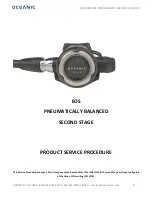
Environmental Equipment, Inc.
IMR 1050X
www.imrusa.com
3634 Central Ave. St. Petersburg, Fl 33711 * Phone 727-328-2818 * 800-RING-IMR * Fax 727-328-2826
Email:
Page 13 of 21
Other Important Factors Related To Combustion
• The three T’s of combustion
– Time
• Amount of time that the fuel and oxygen are together in the combustion chamber
– Temperature
• How high the temperature is determines the rate of oxidation, or speed of the combustion
– Turbulence
• How well the fuel and air are mixed
• These three factors are all interrelated, and will move your results along the combustion curves.
Combustion Measurement Terms
Other parameters measured include net temperature, draft and efficiency.
Net Temperature
Net temperature is the difference between the combustion air entering the combustion chamber and the flue gas
temperature past the heat exchange. This is used to determine how efficient the system is extracting heat from
the combustion process in addition to the performance of the combustion process. On sealed systems that have
ducted inlet air for combustion air, the net temperature must compare this air stream temperature with the flue
gases. If the appliance simply uses room air for the combustion air, our analyzers have an internal temperature
sensor in the handset, so it will use this temperature when calculating net temperature.
The most accurate results for efficiency are obtained when measuring flue gases at the point where flue
temperature (not flame temperature) is the highest.
Draft
Draft is the difference between the ambient pressure level and the pressure level in the flue. This is created either
by the natural buoyancy of the hot gases created in combustion lifting, or by an inducer fan that assists the flow of
flue gases up the stack. Most combustion equipment will specify the amount of draft that is required for proper
operation.
Draft helps draw combustion air into the combustion chamber, and also helps in mixing the fuel and oxygen.
Without proper draft, the combustion process can spill poisonous by-products into the space where the appliance
is located. This can be a risk to those in the area, or create a danger to residents or employees working near the
combustion equipment.
Efficiency
Efficiency is a measure of how well the fuel is burned to create heat, and how well the generated heat is captured
for the intended use.
The information used to create this value is based on the fuels heating value, the heat lost up the flue and the gas
components in the flue gas. The original method to determine efficiency included many manual methods and
lookup charts. As an example you would measure the CO2 level and the stack temperature and then reference a
slide scale that would give you the relative efficiency number. IMR’s electronic combustion analyzers perform the
measurements on a continuous basis, and can calculate the efficiency as adjustments are being made. Combine
this with a printout and you are able to provide a before and after comparison of the combustion equipment in
relatively little time as part of normal servicing.







































